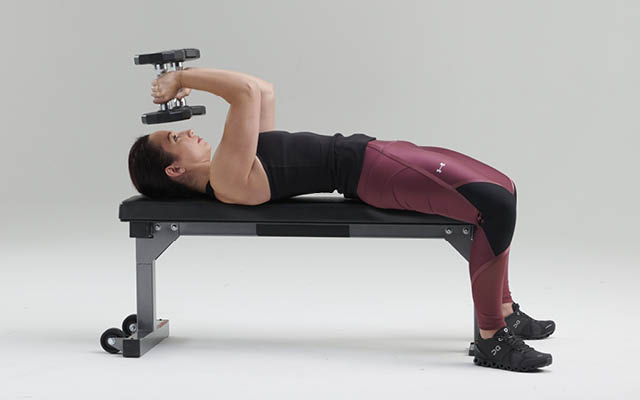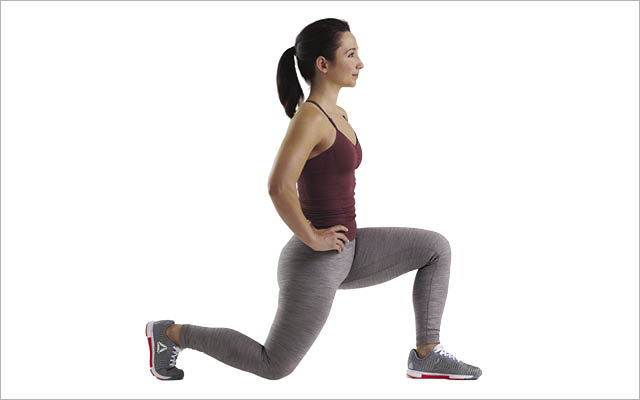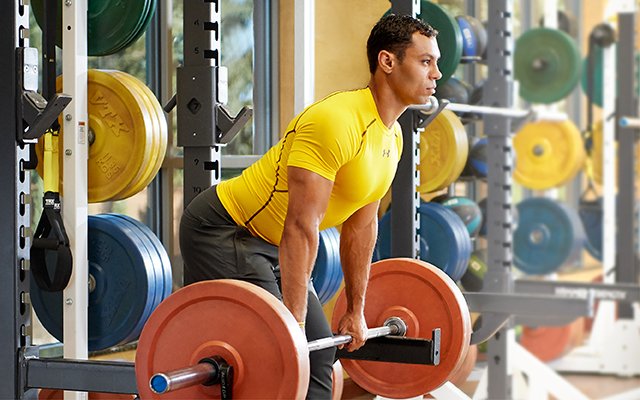People often start to see and feel subtle changes around the four-week point of a new training program: Challenging physical tasks may be easier; clothes might fit better; friends may say you’re looking fitter.
Even if big changes aren’t apparent to the eye, major shifts are occurring. You’re building new muscle mass and burning off body fat, particularly around your belly, where health-threatening fat camps out. New neural connections are proliferating. Your brain is thriving from repeated exposure to mood- and productivity-enhancing hormones. There’s a new elasticity in your connective tissue, new power and vitality in your cardiovascular system.
These changes are your body’s response to the new, beneficial stress of exercise.
If you want to keep adapting, that stress needs to change. That’s what you’ll do this month: New exercises, heavier weights, and new cardio-focused workouts will give your muscles, nerves, and connective tissue something different to adapt to.
Outside the gym, you’ll continue to refine your diet and add some extra mobility work and movement that will keep you limber and loose even on rest days.
Just jumping on board now? Visit “Strong, Fast & Fit: Learning the Ropes (Part II, Month 1)” for Month 1 of this six-month program.
Month 2: Digging In
As in Month 1, you’ll perform two different workouts this month, again called A and B. You’ll alternate between the two workouts on nonconsecutive days, performing a total of three workouts a week, 12 in total over the course of the month. As described last month, you’ll alternate between sets of paired — or similarly numbered — exercises (1A and 1B, for example).
New this month: The sets and reps you perform will vary as the month goes on. In the third chart below, you’ll see the term “rounds.” A round consists of two workouts — one A, one B — performed on two successive workout days. Round 1, for instance, will consist of your first A workout and your first B workout, which you might perform on the first Monday and Wednesday of the month. Round 2, then, will consist of the A workout you perform that Friday, and the B workout you perform the following Monday, and so on through the month.
For each exercise of each round, you’ll perform the sets and reps indicated in the chart. So, in Round 4 — your fourth time through the workout cycle for the month — you’ll do three sets of eight reps for each move in both the A and B workouts.
As your assigned reps go down, the resistance you use will go up. The final reps of each set should be very difficult — particularly in the final set of each move. Practically speaking, that means you’ll use more weight with each move in week five, when you’re tasked with performing six reps of each move, than you did in week two, when you’re tasked with doing 10.
Twice a week this month, you’ll perform brief cardio workouts, called Cardio A and Cardio B. You can do these on separate days from your strength training or on the same days, and you can change when you do them from week to week. Just be sure to perform them after your strength training on days when you double up, and get in two per week every week, for a total of four Cardio A workouts and four Cardio B workouts this month. A sample schedule is below.
Sample Schedule
| Week | Sun. | Mon. | Tues. | Wed. | Thurs. | Fri. |
Sat. |
|
1 |
Rest | Workout A | Cardio A | Workout B | Rest | Workout A; Cardio B |
Rest |
|
2 |
Workout B | Rest | Rest | Workout A; Cardio A |
Rest | Workout B |
Cardio B |
|
3 |
Rest | Workout A; Cardio B |
Rest | Workout B; Cardio A |
Rest | Rest |
Workout A |
|
4 |
Cardio A | Rest | Workout B | Rest | Workout A | Cardio B |
Workout B |
Download Image of Sample Schedule
Prior to each workout, perform the activation and mobility drills outlined in Month 1. For a refresher, visit “Strong, Fast & Fit: Learning the Ropes (Part II, Month 1)”.
The Workouts
|
Workout A |
Workout B |
|
1. Face Pull |
1a. Alternating Reverse Lunge |
|
2a. Assisted Chin-up |
1b. Seated Cable Row |
|
3a. Neutral-Grip Incline Dumbbell Press |
2b. Sprinter Stance Deadlift |
|
3b. Lateral Step-Over |
3. Lying Triceps Extensions |
Download Image of The Workouts
Rounds
|
Round |
Sets x Reps |
|
1 |
2 x 10 |
|
2 |
3 x 10 |
|
3 |
2 x 8 |
|
4 |
3 x 8 |
|
5 |
3 x 6 |
|
6 |
4 x 6 |
Cardio Workouts
Cardio A
Choose any form of cardio you enjoy, indoors or outdoors. After a five-minute ramp up, spend 20 to 30 minutes on the activity at a comfortable pace (6 of 10 on an effort scale). Cool down with light movement or stretching for five minutes.
Cardio B
Perform your cardio activity of choice at an easy pace (4 of 10 on an effort scale) for five minutes. Then spend one minute at a challenging pace (8 of 10) followed by two minutes at a recovery pace (5 of 10). Repeat the three-minute work–rest cycle a total of five times.|
Exercises
Face Pull
- Loop a handled exercise band around a pull-up bar (or attach a two-handled rope attachment to a cable machine set to just above shoulder height).
- Face the anchor and take a neutral (palms in) grip on the handles.
- Step backward to create some tension with your arms extended directly forward from your shoulders (this is your starting position).
- Keeping your elbows up (not drawing them down to your sides), slowly pull the rope handles back. Strongly contract the muscles in the backs of your shoulders and upper back, and hold for a one-count.
- Slowly reverse the move and repeat for reps.
Band-Assisted Pull-Ups
- Drape an exercise band (the kind that looks like a giant rubber band) over a chin-up bar, pull the back loop through the front one, and pull tight.
- Stand on a chair, box, or bench placed beneath the chin-up station and loop the bottom of the exercise band around one knee.
- Take an overhand, shoulder width grip on the chin-up bar and step off the stool. You should feel as if the band is propelling you upward. If not, either tie a knot in the band to shorten it or use a thicker band.
- Without swinging or jerking, pull yourself up until your chin clears the bar.
- Reverse the movement, lowering yourself until your arms are fully extended. Repeat for reps.
Band-Assisted 1.5 Goblet Squat
- Place a small, light exercise band around your knees and stand, holding a single kettlebell, with your feet parallel and shoulder width and your heels elevated on two 5-pound plates.
- Raise the kettlebell to the rack position and hold the “horns” of the bell just below your chin. Tuck your elbows in and raise your chest high. This is your starting position.
- Keeping your chest up, your gaze forward, and your lower back in its natural arch, bend your knees and hips, spreading your knees apart (against the resistance of the band) and dropping your hips until the tops of your thighs are parallel to the floor.
- Pause, reverse the move, and come up halfway out of the squat.
- Drop again to a full squat.
- Pause, reverse the move, and come all the way out of the squat: That’s one rep.
Neutral-Grip Incline Dumbbell Press
- Set an adjustable exercise bench to about a 30-degree angle to the floor.
- Sit on the seat of the bench, holding two dumbbells on your lap.
- Lie back on the incline bench and raise the dumbbells to shoulder height, boosting them with your knees if necessary. This is your starting position.
- Keeping your palms parallel, slowly press the dumbbells to arm’s length above you.
- Slowly reverse the move, drawing your shoulder blades together as you return to the starting position.
- Repeat for the appropriate number of reps.
Lateral Step-Over
- Stand to the right of a 12- to 18-inch box or bench (the higher the box, the tougher the move).
- Step your left foot onto the box.
- Step onto the box with your right foot and stand upright.
- Step your left foot off the left side of the box.
- Bend your right knee, lowering your left foot to the floor.
- Reverse the move, stepping your left foot back onto the box.
- Stand upright on the box.
- Continue stepping off the box alternately with your left and right feet until you’ve completed the full count of reps with each leg.
Alternating Reverse Lunge
I am text block. Click edit button to change this text. Lorem ipsum dolor sit amet, consectetur adipiscing elit. Ut elit tellus, luctus nec ullamcorper mattis, pulvinar dapibus leo.
- Stand tall with your feet parallel and shoulder width.
- Keeping your feet parallel and your torso upright, step your right leg back about 2 feet and place the ball of your right foot on the floor.
- Keeping your shoulders and hips square, slowly bend your knees until your right knee is 1 inch from the floor.
- Reverse the move and step your right foot back to the starting position.
- Repeat with your left leg and continue alternating sides until you’ve completed the appropriate number of reps on each side.
- Too easy? Hold dumbbells in your hands.
Seated Row
- Loop a handled exercise band around a pull-up bar (or clip a parallel-grip attachment to a seated-cable-row machine).
- Sit on a box or bench (or in the cable-row unit), facing the anchor point, and take hold of the handles of the attachment.
- Keeping your torso stationary, pull your shoulder blades and elbows back as far as possible.
- Pause and hold for a moment, squeezing your shoulder blades together as much as possible for a one-count.
- Slowly return to the starting position.
Dumbbell One-Arm Overhead Press
- Stand upright, left foot slightly in front of your right, holding a dumbbell in your right hand.
- Lift the dumbbell to shoulder height, with the palm of your right hand facing inward.
- Keeping your torso vertical, exhale and press the dumbbell to arm’s length overhead.
- Slowly lower the dumbbell back to the starting position and repeat for the assigned reps.
- Switch hands and repeat the move.
Sprinter-Stance Deadlift
- Holding a medium-heavy barbell at arm’s length in front of your thighs, unlock your knees and assume a sprinter stance: right foot forward, left foot about 8 inches back, left heel off the floor. This is your starting position.
- Keeping your lower back in its natural arch and keeping the bar close to your legs, slowly hinge forward at your hip joints.
- Pause in the stretched position, then slowly return to the starting position.
- Repeat the move for half of the assigned number of reps (five if the assigned reps are 10, four if the assigned reps are eight, and so on), put the weight down, pause, and repeat the same number of reps with your left foot forward.
Lying Triceps Extensions
Outside the Gym
1. Become a NEAT freak: Incidental daily tasks, such as taking the stairs at the mall, walking with friends or family, or doing chores around the house, fall under the heading of what physiologists call NEAT — non-exercise activity thermogenesis. Over the course of a day, it keeps your metabolism stoked and your blood sugar under control. This month, look for ways to increase your NEAT. One simple tip: Drink a big glass of water every time you sit down at your desk. About 20 to 30 minutes later, heed the call of nature. That’s a half-dozen strolls to the bathroom each day — a nice NEAT boost.
2. Get your stretch on. Once a day — after your workout or before bed — perform this full-body mobility drill:
- From the pushup position, step your right foot forward and place it on the floor to the right of your right hand (your right knee should be near your right shoulder).
- Straighten your left leg as much as possible and keep it there throughout the move. Contract your right glute muscles.
- Reach your right hand under your body as if trying to touch something on the floor near your left hip.
- Reach your right hand up and back behind you, extending your fingertips toward the ceiling. Pull your right shoulder blade back toward your spine.
- Perform 10 reps, switch sides, and repeat.
3. Add some color. There’s a reason multicolored salads always look delicious: They’re more complete and nutritious than monochromatic meals. This month, take a look at your intake of fruits and vegetables and try to fill in gaps in the color wheel. No reds? Add tomatoes, apples, strawberries. No yellows? Add yellow peppers, squash, bananas. At least once a week, grab something from the produce aisle you haven’t eaten for at least six months. Like it? Keep it in the rotation. Variety is the spice of health.




This Post Has 0 Comments